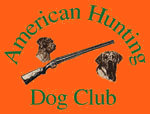

Copyright © 1996-2024, The
American Hunting Dog Club
The HID test will evaluate seven (7) separate and distinct instincts: nose, search, pointing/flushing, trailing, retrieving, desire, and cooperation. In addition, it will evaluate four other hereditary characteristics that play a major role in the trainability and future usefulness of a dog: coat, conformation, temperament, and reaction to gunfire.
The dog's nose will be judged primarily during the search and tracking tests, but will be judged at all times where demonstrated. We can forgive the young dog that occasionally points a turtle or non-game species.
The object of the search is to find game with the nose. The HID will not have had time to learn a pattern that will cover all of a field. He should be given the chance by handler guidance and assistance to work various wind directions. A chase gives us an excellent opportunity to judge desire and cooperation. Range is not a liability as long as the dog works for the handler and continues to search new ground. The search will last up to twenty minutes or until the judges feel that they can make a good evaluation.
The dog must demonstrate the ability and willingness to follow the trail of live game. Trailing, if the opportunity arises, may be judged during the search. A guided live bird will be rendered flightless and a few body feathers placed on the ground at the start of a trail. The trail will be as long as the bird, cover and terrain reasonably allows. A live bird will be led with a long pole and line. The live bird will be picked up and a dead bird will be left at the end of the trail. The handler will then be shown the starting point and the line of the trail. He will then start the dog on the trail and when it is trailing the scent, release it. The handler should work with the dog and not release it until it is settled on the trail or until the judge directs him to release the dog. The handler should then stay where he is and encourage or help the dog if need be. A retrieve is not required, but may influence the dog's cooperation and retrieving score.
The dog must demonstrate a strong retrieving instinct. Delivery of the dummy to the handler is not required. The dog must enter the water twice and swim for a thrown dummy, grasp it, and start back toward the handler. At their discretion, the judges may ask that the dog enter the water additional times. The host group will supply several dummies. The handler will select one, get the dog interested in it, and throw it into swimming depth water. The dog may break with the throw or be encouraged to go.
The dog must show a keen willingness to work at all times. This is best shown by the dogs attitude, more than by his speed, range or the completion of a given task. Desire will be judged in all phases of the test.
Cooperation is the innate willingness that a dog has to work with and to please his handler. For example, a chase gives us an excellent opportunity to judge both desire and cooperation in relation to one another. Cooperation will be judged during all phases of the test.